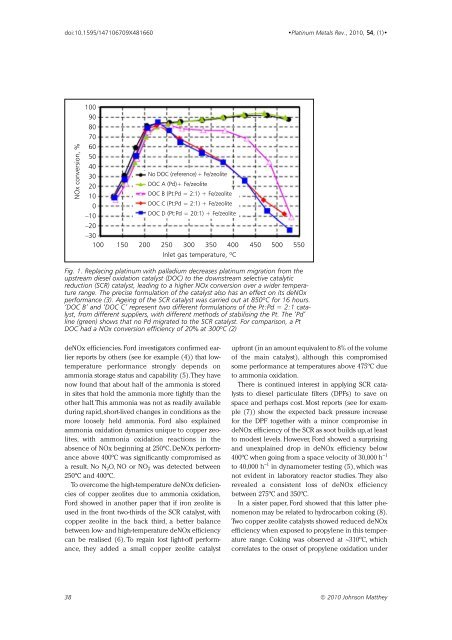Download Issue PDF - Platinum Metals Review
Download Issue PDF - Platinum Metals Review
Download Issue PDF - Platinum Metals Review
You also want an ePaper? Increase the reach of your titles
YUMPU automatically turns print PDFs into web optimized ePapers that Google loves.
doi:10.1595/147106709X481660<br />
•<strong>Platinum</strong> <strong>Metals</strong> Rev., 2010, 54, (1)•<br />
NOx conversion, %<br />
100<br />
90<br />
80<br />
70<br />
60<br />
50<br />
40<br />
30<br />
20<br />
No DOC (reference) + Fe/zeolite<br />
DOC A (Pd)+ Fe/zeolite<br />
10<br />
0<br />
–10<br />
DOC B (Pt:Pd = 2:1) + Fe/zeolite<br />
DOC C (Pt:Pd = 2:1) + Fe/zeolite<br />
DOC D (Pt:Pd = 20:1) + Fe/zeolite<br />
–20<br />
–30<br />
100 150 200 250 300 350 400 450 500 550<br />
Inlet gas temperature, ºC<br />
Fig. 1. Replacing platinum with palladium decreases platinum migration from the<br />
upstream diesel oxidation catalyst (DOC) to the downstream selective catalytic<br />
reduction (SCR) catalyst, leading to a higher NOx conversion over a wider temperature<br />
range. The precise formulation of the catalyst also has an effect on its deNOx<br />
performance (3). Ageing of the SCR catalyst was carried out at 850ºC for 16 hours.<br />
‘DOC B’ and ‘DOC C’ represent two different formulations of the Pt:Pd = 2:1 catalyst,<br />
from different suppliers, with different methods of stabilising the Pt. The ‘Pd’<br />
line (green) shows that no Pd migrated to the SCR catalyst. For comparison, a Pt<br />
DOC had a NOx conversion efficiency of 20% at 300ºC (2)<br />
deNOx efficiencies. Ford investigators confirmed earlier<br />
reports by others (see for example (4)) that lowtemperature<br />
performance strongly depends on<br />
ammonia storage status and capability (5).They have<br />
now found that about half of the ammonia is stored<br />
in sites that hold the ammonia more tightly than the<br />
other half.This ammonia was not as readily available<br />
during rapid, short-lived changes in conditions as the<br />
more loosely held ammonia. Ford also explained<br />
ammonia oxidation dynamics unique to copper zeolites,<br />
with ammonia oxidation reactions in the<br />
absence of NOx beginning at 250ºC. DeNOx performance<br />
above 400ºC was significantly compromised as<br />
a result. No N 2 O, NO or NO 2 was detected between<br />
250ºC and 400ºC.<br />
To overcome the high-temperature deNOx deficiencies<br />
of copper zeolites due to ammonia oxidation,<br />
Ford showed in another paper that if iron zeolite is<br />
used in the front two-thirds of the SCR catalyst, with<br />
copper zeolite in the back third, a better balance<br />
between low- and high-temperature deNOx efficiency<br />
can be realised (6). To regain lost light-off performance,<br />
they added a small copper zeolite catalyst<br />
upfront (in an amount equivalent to 8% of the volume<br />
of the main catalyst), although this compromised<br />
some performance at temperatures above 475ºC due<br />
to ammonia oxidation.<br />
There is continued interest in applying SCR catalysts<br />
to diesel particulate filters (DPFs) to save on<br />
space and perhaps cost. Most reports (see for example<br />
(7)) show the expected back pressure increase<br />
for the DPF together with a minor compromise in<br />
deNOx efficiency of the SCR as soot builds up,at least<br />
to modest levels. However, Ford showed a surprising<br />
and unexplained drop in deNOx efficiency below<br />
400ºC when going from a space velocity of 30,000 h –1<br />
to 40,000 h –1 in dynamometer testing (5), which was<br />
not evident in laboratory reactor studies. They also<br />
revealed a consistent loss of deNOx efficiency<br />
between 275ºC and 350ºC.<br />
In a sister paper, Ford showed that this latter phenomenon<br />
may be related to hydrocarbon coking (8).<br />
Two copper zeolite catalysts showed reduced deNOx<br />
efficiency when exposed to propylene in this temperature<br />
range. Coking was observed at ~310ºC, which<br />
correlates to the onset of propylene oxidation under<br />
38 © 2010 Johnson Matthey
















